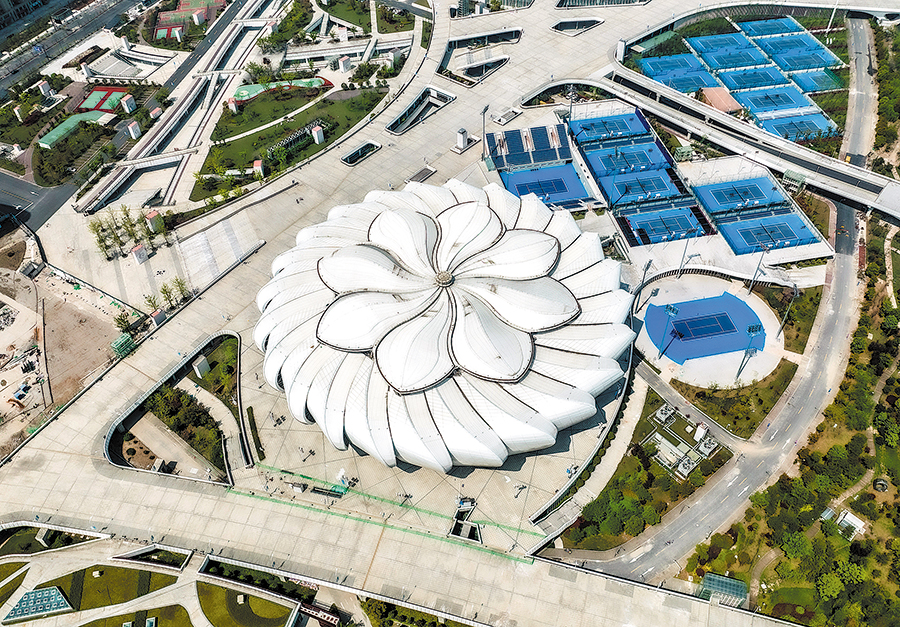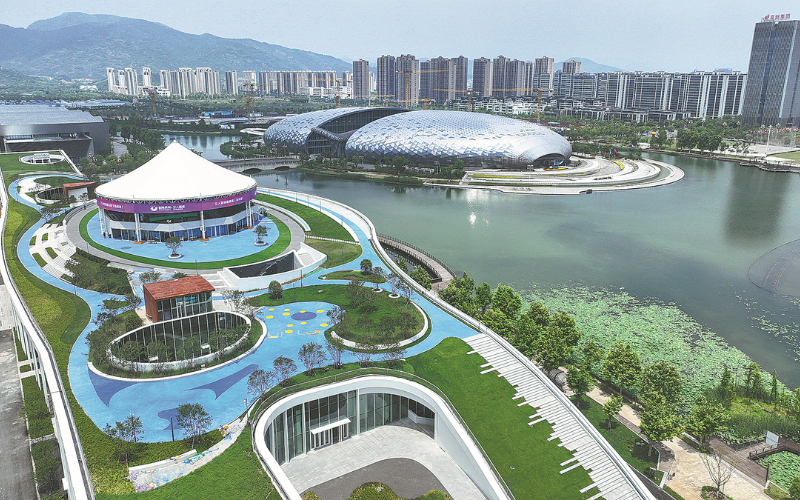Hangzhou goes all out to host green Asian Games

Hangzhou Olympic Sports Centre Tennis Centre. [Photo/China Daily]
Sustainable venues
Some 24,000 square meters of the roof area at the Fuyang Water Sports Centre is covered by soil and adorned with various plants, blending seamlessly with the surrounding natural landscape.
The venue has a 45 percent greenery ratio and provides carbon sequestration, oxygen release and heat insulation while reducing rainwater runoff. Carbon sequestration is a natural or artificial process in which carbon dioxide is removed from the atmosphere and held in solid or liquid form
Under the venue's gravel garden area, underground system recycles rainwater. After being filtered through gravel and permeable fabrics, rainwater is used for the atrium display, fountains and irrigation. This system saves some 1,000 metric tons of water per month.
Only 12 of the 56 venues for the Asian Games in Hangzhou are newly built.
Among them, the Shaoxing Baseball and Softball Sports Center in Shaoxing, Zhejiang province, is the largest, with a seating capacity of 10,000. Its design incorporates elements such as Shaoxing's textile heritage, traditional boats and calligraphy.
The venue's interior public space is cleverly integrated with the surrounding community, creating an organic connection.
In addition to the competition areas, it features a hotel, a community fitness center and commercial areas capable of meeting diverse post-event operational needs.
Chen Yuewei, a publicity officer for Shaoxing, said the venue is poised to become a vital service center.
Furthermore, the authorities in Shaoxing are pushing for a national-level baseball and softball youth training center to be established in the city.
Meanwhile, the Shaoxing Keqiao Yangshan Sport Climbing Centre used to be the site of an abandoned mine. Construction and development work has transformed it into an international competition venue and youth sport climbing base. The center, which resembles a cocoon, features a semi-open design, allowing athletes and spectators to enjoy views of the Yangshan Scenic Area.
The other 44 competition venues have either been renovated or are temporary constructions, with the emphasis placed on adopting prefabricated building techniques and using sustainable and renewable materials.
For example, amenities in the Guobo Squash Hall at the Hangzhou Olympic Sports Center, such as glass walls and spectator seating, can be dismantled, allowing the venue to be reused after the Games.
Zhou Congcong, director of maintenance services at the venue, said, "We are donating one of the squash courts to the Asian Games Museum, with the other seven courts being offered to local communities, schools and educational institutions, ensuring their continued contribution to promoting the sport."
Emissions curbed
Green energy sources are being used at all the Asian Games competition venues.
Some of the green electricity used at the venues is photovoltaic energy transmitted from areas such as the Qaidam Basin in Qinghai province, the Jiayu Pass in Gansu province, and the Loess Plateau in north-central China. State Grid Hangzhou Electric Power Supply Co said wind power for the Games is generated in areas such as the Xinjiang Uygur autonomous region.
The term "green electricity" refers to electricity production processes with minimal to zero carbon dioxide emissions, reducing the environmental impact when compared with conventional power generated from fossil fuels.
Chen Rong, director of the venue construction and management department for the 19th Asian Games Organizing Committee, said, "The green power agreement for the Games now stands at 220 million kilowatt-hours, reducing carbon dioxide emissions by 115,400 tons."
Hangzhou has also been promoting the use of electric vehicles and enhancing its green transportation system. State Grid Hangzhou Electric Power Supply Co has gone to great lengths to ensure that all the Games venues are equipped with charging stations.
The company has also installed China's first high-power wireless charging station for new energy vehicles at the Asian Games Village in Hangzhou's Xiaoshan district. With 102 charging stations and 2,024 charging points established, the company offers comprehensive support services for green transportation during the Games.
Even the mascots for the Games showcase an innovative approach to sustainability.
Their fabric was produced by using digital printing technology, which, unlike traditional methods, does not produce any waste water, gas or pulp. To minimize air pollution, the mascots are cut out by workers using electric scissors instead of laser machines. The electricity used to produce the mascots was generated from photovoltaic installations on the factory roof.
Furthermore, a diverse range of eco-friendly licensed products has been created for the Games, including backpacks made from 10 recycled bottles and frisbees crafted from 1,000 grams of rice husks.
Hua Fang, who works for the Hangzhou Asian Games Organizing Committee's market development department, said, "Licensed merchandise serves as distinctive event keepsakes, and we also promote the use of new concepts and technologies in product design and development."
To stage the first carbon-neutral Asian Games, the authorities in Zhejiang launched a digital management platform on July 11. The platform uses digital technology to oversee management of carbon emissions in six cities, and includes functions such as data collection, accounting, emissions reduction and evaluation.
A statement from the Hangzhou Asian Games Organizing Committee's environmental protection department said: "The carbon footprint of a large sporting event covers many aspects, including construction of the competition venues, transportation, accommodations, competition preparations, and spectators.
"It is very difficult for humans to evaluate all this. With the platform, we only need to input and check raw data. Carbon emissions are automatically calculated by the system."

Deqing Geographic Information Park Basketball Court. [Photo/China Daily]
Low-carbon initiative
Meanwhile, a "low-carbon account" program has been designed for residents of the Asian Games Village, including athletes, technical officials, media representatives and volunteers.
This initiative harnesses the capabilities of Alibaba Cloud's artificial intelligence algorithms and dual carbon products to encourage low-carbon living among the village residents.
Residents earn points for their accounts by adopting eco-friendly practices in the village, such as recycling packaging and bottles, as well as refraining from using plastic bags for shopping. These points can be exchanged for Asian Games memorabilia, including badges made from low-carbon, environmentally friendly materials.
Outside the village, preparations for the Asian Games helped foster the concept of a green lifestyle in Hangzhou.
Hu Fangfang, a resident of the city who has volunteered to promote waste sorting in her community, said, "Although this task is formidable, and developing good habits takes time, I believe that with our collective efforts, everything is moving in the right direction."
Sun Yi, an environmental protection volunteer in Hangzhou, said: "Everyone is an active participant in making the Asian Games go green. It's not just about encouraging others, but more important, taking action in our daily lives."
To seek more ways to achieve carbon neutrality, institutions, companies and individuals are encouraged to donate their carbon credits and carbon allowances for the Asian Games.
By using Ant Forest, a mobile platform developed by Ant Group, participants can donate the virtual green energy points they collect for eco-friendly activities, such as using public transportation.


